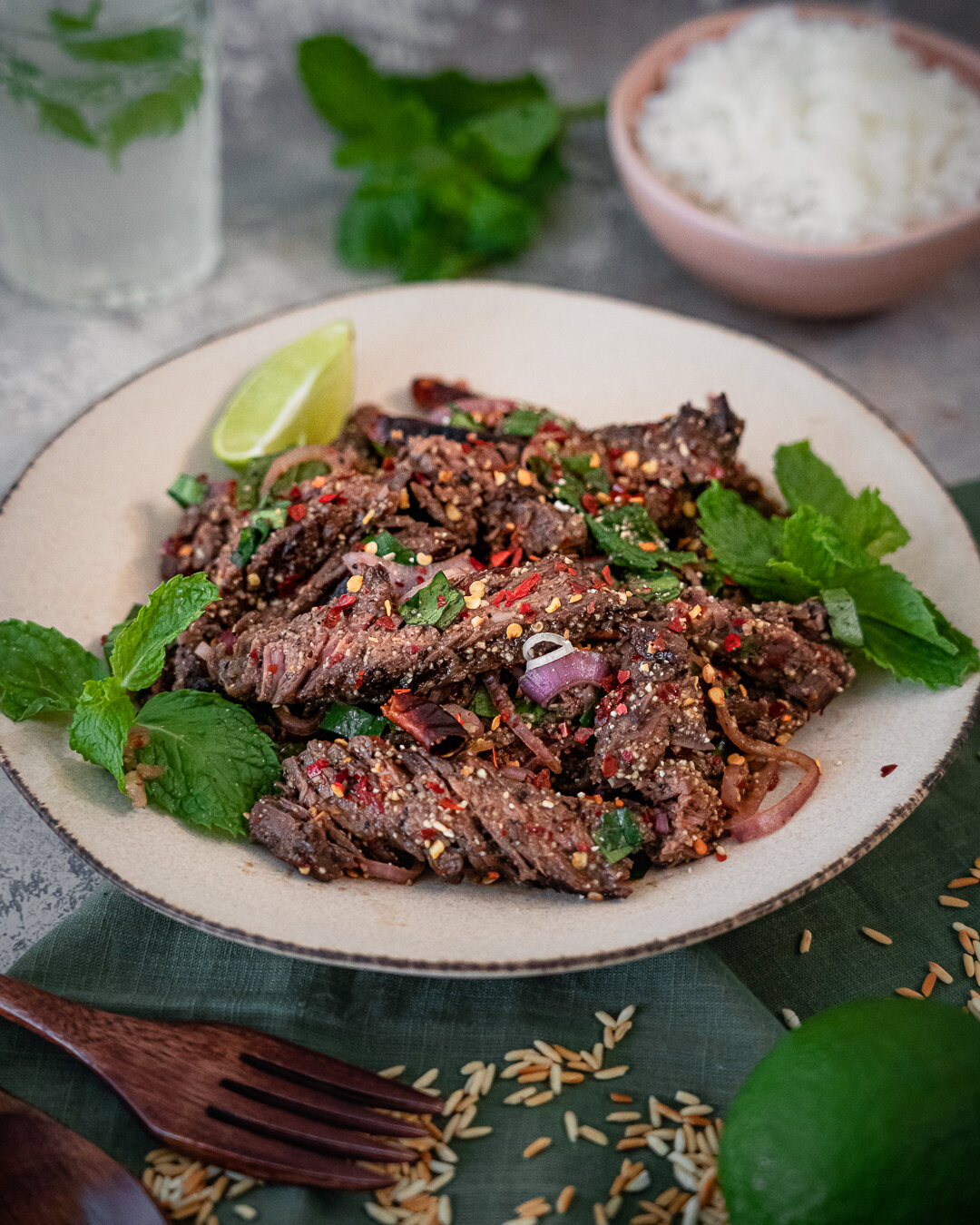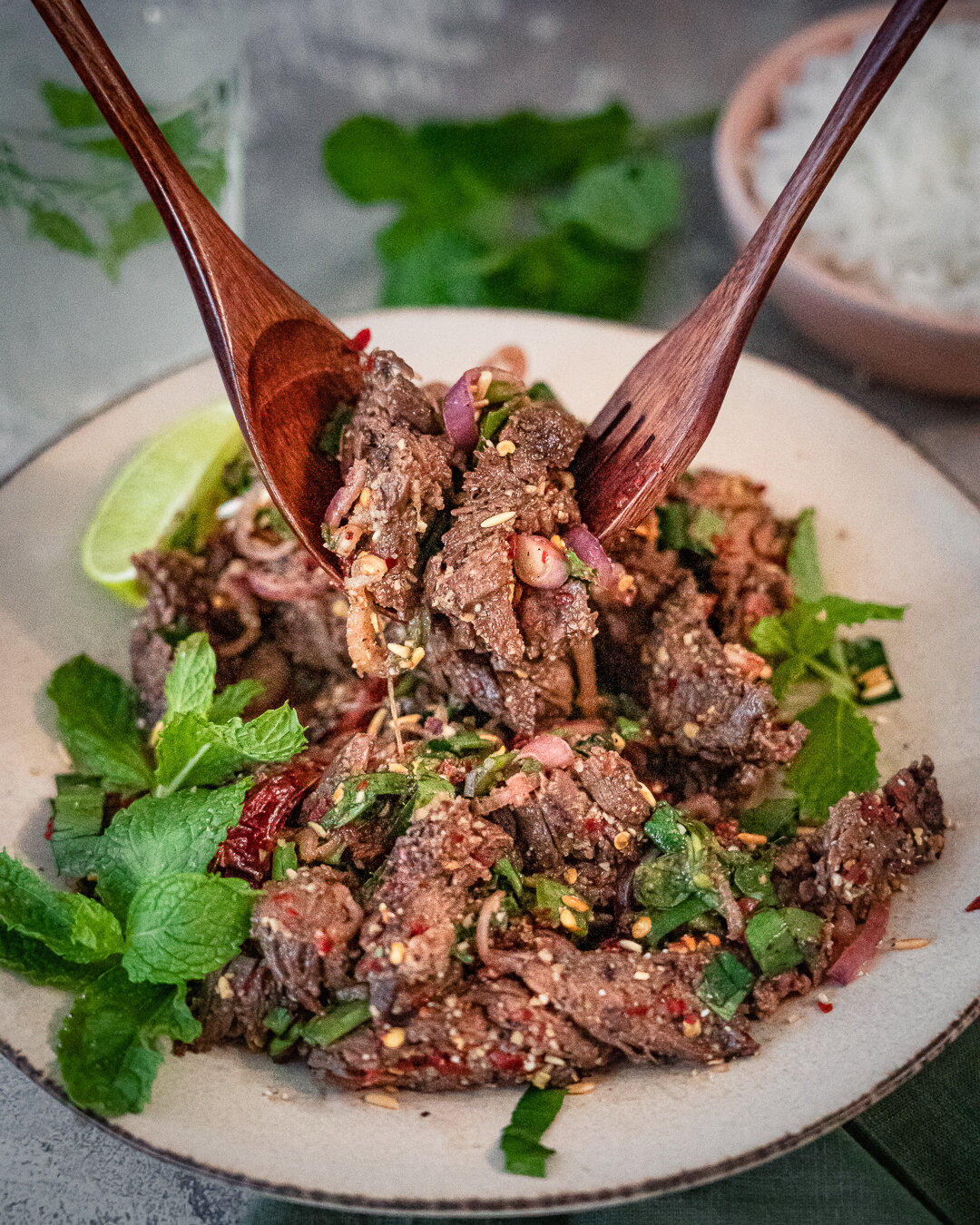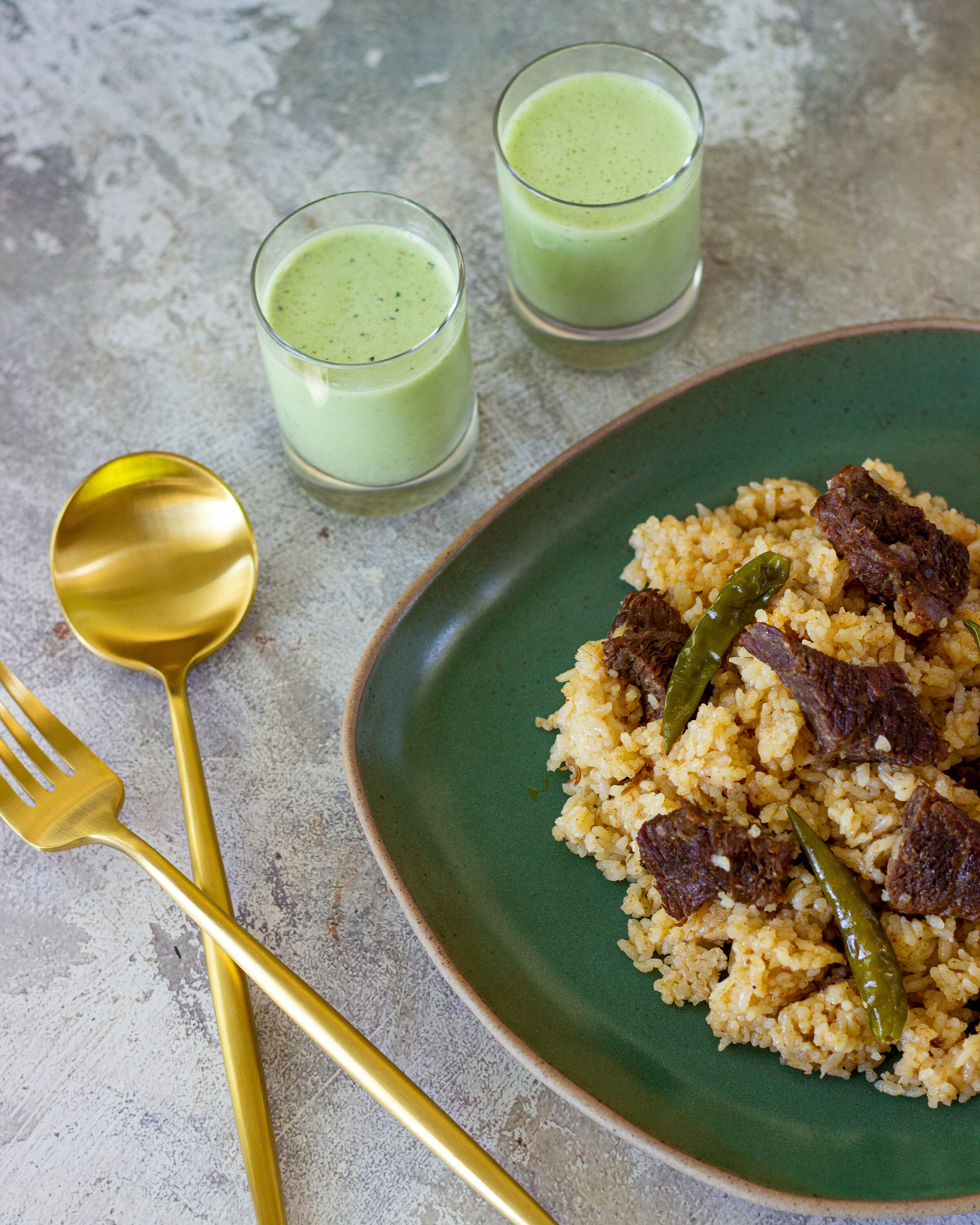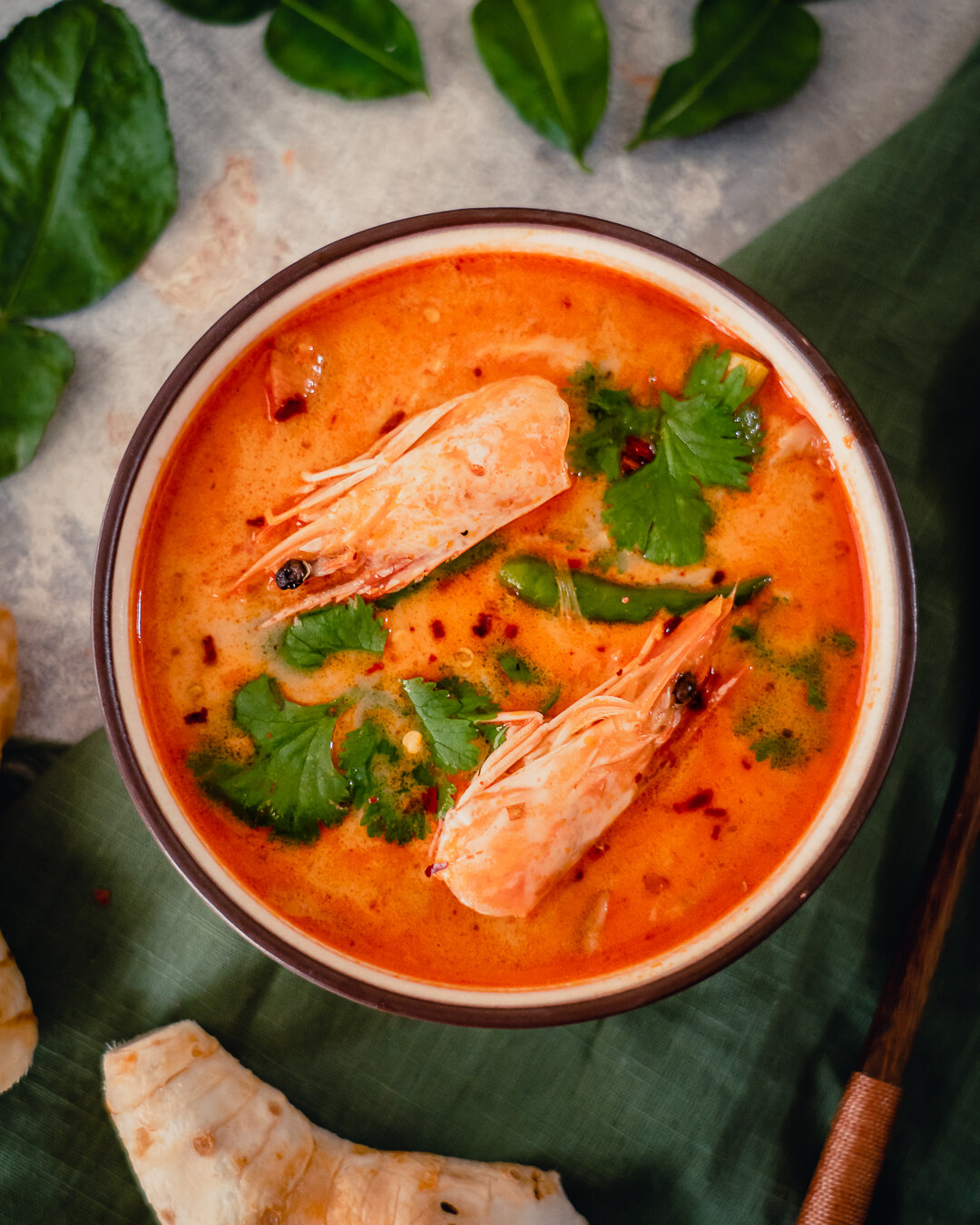Waterfall Grilled Beef Salad

This is a Northeastern Thai and Lao specialty and one of my favorite summertime salads. Nam Tok Neua in Thai literally translates to “waterfall beef”. The name specifically refers to the experience of nam tok as in “waterfall” which is the dripping of fat and meat juices onto the charcoal while grilling the beef or neua in Thai.
If you are familiar with Thai cuisine, the ingredients for this salad may seem uncannily similar. That is because nam tok is essentially a laab dish, but instead of ground meat, the meat here is grilled. Once the beef begins to hiss from the sizzling juices, it is removed from the grill, and sliced and mixed into the salad. The waterfall sizzling sound is how you know the beef is cooked and ready to be eaten. At its core, you're grilling meat with very little marinade, then cutting, seasoning and tossing a salad. This is a very quick and easy dish to make and the ingredients are available in most local groceries. But for a simple salad, it packs a punch with so many Thai flavors.
Thai Salads
There are no shortages of salads in Thai culture. When I say “salad”, unlike the western word, I am loosely defining Thai dishes that are made by mixing ingredients, mainly protein with fresh vegetables, herbs and a dressing. Thai salads often do not have raw vegetables or fruit as their main ingredient but use meat, seafood, eggs, tofu and noodles instead. Protein is always the star and it could be grilled, ground, blanched, fried, dried, sausag-ed and just about everything in between. Unlike the leafy greens in western salads, vegetables and herbs in Thai salads add elements like freshness and texture - crisp and juicy vegetables such as papaya, long beans, eggplants, cucumber, tomatoes and flavorful herbs like mint, green onion, lemongrass, shallots and various different types of basils and corianders.
Salads are not served as entrées but normally eaten as one of the main dishes in a Thai buffet-style meal, together with rice (depending on the region this can be glutinous rice or non-glutinous rice) or Thai rice noodle called khanom chin. In Thailand, there are also specialized restaurants which serve a wide variety of Thai salads as side dishes. Basically, salads are so much in abundance in this culture that depending on the type it can be eaten as a main dish, side dish or even a snack on their own.
Different Types
Speaking of types, with so many varieties of salads in Thailand, they are distinguished into four different categories according to their method of preparation. The major types of Thai salads are yum, pla, tum, and laab.
Yum - literally means “mix” and you can yum just about any combination of protein, vegetable, fruit, herb, spice and noodle. The basic yum dressing must always include these ingredients - fresh shallots, fish sauce, lime juice, palm sugar and fresh chillies. With this simple dressing, you can create endless kinds of yum by varying the ratio of sour, sweet, salty and spicy to match your main ingredients. My favorite yum style salad is Yum Wunsen, a glass noodle salad packed with lots of crunchy peanuts and dried shrimps.
Pla - this style of salad is made with proteins that are more cured and undercooked, usually rare to medium. Think of a Thai style ceviche where the acid from the lime juice is used to cook and cure the protein, specifically seafood and beef. The dressing is similar to yum but along with shallots, fish sauce, lime juice, and chillies, pla style salads must include large amounts of thinly sliced lemongrass and sometimes mint. Some of the modern versions of this style of salad nowadays include nam phrik phao, a sweet roasted chili paste. Pla is an old cooking technique that is quickly disappearing, possibly due to fear of food borne illnesses associated with raw and under-cooked meat. I love a good bowl of Pla Goong, a spicy prawn salad, which consists of just-cooked shrimp dressed with a sour-savory-sweet mixture and lots of fresh herbs and chilies.
Tum - means to pound using a traditional mortar and pestle and this is exactly how these salads are made. The basic dressing for a tum-style salad includes garlic, fresh bird’s eye chilies, fish sauce, lime juice, tamarind juice, dried shrimp and palm sugar. The dressing is pounded and mixed together, sometimes the additional ingredients are also slightly pounded to release their flavors. The poster child of tum is the world famous Som Tum, green papaya salad which is also considered one of Thailand’s national dishes, as well as a personal favorite of mine.
Laab - one of the most well-known salads internationally, this type of salad comes from the Isan province in Northeastern Thailand as well as Laos. Laab is always made with ground meat or ground seafood of any kind. The spicy and very tart style of dressing must always include lime juice, fish sauce, ground dried chilies and a very important ingredient called khao khua, which is ground dry toasted rice, giving the salad a specific nutty flavor. Traditionally, there is no added sugar to round off the acid so the toasted ground rice fills the important balancing role. One of my go to weeknight dish is Larb Gai, which is cooked minced chicken tossed with a spicy-sour dressing, fresh herbs, shallots and a lot of toasted ground rice.
Nam Tok - the unsaid fifth type of Thai salad is essentially a derivative of laab but with one major difference - the meat is grilled then thinly sliced, rather than ground. It refers to a popular meat dish in Laos called ping sin nam tok and in Isan, Northeastern Thai province, where it is commonly known as nuea yang nam tok. It is traditionally eaten with sticky rice and comes with raw vegetables such as yardlong beans and cabbages. Because nam tok refers to the “waterfall” or dripping of fat/juice through the grill grates into the fire, the meat cannot be cooked in any other method, it must always be grilled.
Now that I have explained the five major types of Thai salads, let’s dive into my all time favorite summer salad Nam Tok Neua or in English called Waterfall Grilled Beef Salad. Given how much us westerners love our grilled meat and barbecue, this was an immediate hit among our family and friends. I also noticed some eerily familiar ingredients that reminded me of certain ingredients from my ethnicity which is Bengali. I will explain that in the end but first the recipe!
Recipe: Nam Tok Neua
Serves: 2
The Meat
Beef - 1 lbs, sirloin, striploin, rib-eye, flank steak or any other type of steak you prefer for grilling
Light Soy Sauce - 2 tbsp
Black Peppercorns - 2 tsp, ground
Vegetable Oil - 1 tbsp
Combine all the ingredients except for the beef in a large zip-loc bag. Add the beef in the bag, squeezing out as much air as possible. Gently massage the meat to ensure it is evenly coated in the marinade. Marinate in the fridge for at least 2 hours and up to 1 day.
The Dressing
Fish Sauce - 3 tbsp
Lime Juice - 3 tbsp, I like to use traditional Thai Makrut limes but regular lime works as well
Thai Chilli Flakes - 2 tsp, I used 3 but I like it when it burns lol. If you dont want to get Thai chili flakes, Italian ones will do.
Palm Sugar or Brown Sugar - 2 tsp (optional)
Combine the fish sauce and palm sugar in a bowl and use the back of a spoon to smoosh the palm sugar to allow it to dissolve. Add the chilli flakes, and lime juice. Make sure to taste test and adjust the seasoning to your preference.
Note: Traditionally sugar is not used in the dressing because the toasted ground rice is used to balance the flavor. Although, I have seen several modern day variations that do use sugar nowadays. I personally like to use a bit of palm sugar to balance out the heat since I make it really spicy (as it should be!). If you cannot find palm sugar, feel free to use brown sugar or white sugar.
Khao Khua | Toasted Ground Rice
Uncooked Sticky Rice or Jasmine Rice - 3 tbsp
In a dry frying pan, add the rice and toast over medium-high heat, moving the grains constantly, until they turn a deep golden-brown color. This should take about 5-8 minutes.
When ready to use, grind into a powder using a mortar and pestle or an electric spice grinder. If not using immediately, do not grind the rice and store it in an airtight container at room temperature. The fragrance from the rice fades over time so only make as much as you need.
Vegetables & Herbs
Asian Shallots - 3, julienned, if you don’t have shallots use ⅓ cup red onions
Spring Onions - 3, chopped
Mint - 1 cup, large leaves chopped, small leaves left whole
Sawtooth Coriander - 4, chopped, if you can’t find it use regular cilantro
Prep all the vegetables and herbs. Set it aside.
Grilling the Meat
Bring the steak to room temperature 30 minutes before grilling. Remove from the marinade and shake off any excess. Preheat the grill, then cook the steaks to your preferred doneness. I recommend medium or medium-rare because the meat will cook and cure again in the acidic dressing. Let the steak rest for at least 5 minutes before cutting.
Assembling the Salad
In a large mixing bowl, toss and separate the sliced shallots. Slice the beef against the grain, into very thin, bite-sized slices and combine with the shallots while it is still warm. Don’t forget the extra pan dripping from the beef, it’s all flavor. Add the rest of the herbs: spring onion, mint and sawtooth coriander. Add the dressing and the toasted ground rice, toss until well combined. Taste and adjust the seasoning with more lime juice, fish sauce and chili flakes to your preference.
Note: Do not toss the salad with the dressing until ready to serve as the meat will continue to cook in the acid of the lime juice.
Garnish it with additional mint sprigs and serve with sticky rice and fresh vegetables like cabbages and yardlong beans (traditional) or cucumber, cherry tomatoes, sweet corn and red radishes (non traditional). The sticky rice soak up the juices from the salad and the vegetables add extra crunch and freshness. Serve warm or at room temperature.
Similarity with Bengali Culture
Considering how many Bengali readers I have, I wanted to add a few hacks that can be used straight from the Bengali kitchen/pantry.
Muri (Puffed Rice) - if you are dreading making Khao Khua, you can microwave Muri for 1 minute and then grind it in a mortar and pestle or a spice grinder. It will add the similar nutty and crunchy flavor as the traditional Thai toasted ground rice.
Yardlong beans - most Bengalis will recognize this as Borboti, which is traditionally cooked in stir fries with potatoes or small fish. In Thai cuisine, they are eaten both fresh and cooked, used in curries and stir-fried dishes, but also served raw in salads like Som Tam and Nam Tok. I didn’t add it as a side condiment to my salad this time but if you have it at home, feel free to try it.
Lime - this is a quintessential ingredient to both Bengali and Thai cuisine. If you grew up in a very traditional Bengali home and attuned to your Bengali roots, like me, you may recognize a certain type of lime we eat called Gondhoraj Lebu also known as Kagji Lebu, known for it’s distinct textured skin and aroma. In English, it is called Rangpur lime although it originated in the picturesque hills of Sylhet and Chittagong in Bangladesh. The Thai Makrut lime otherwise known as Kaffir lime is actually a distant cousin of the Bengali Rangpur lime.
Asian Shallots - again most Bengalis will recognize these small and pale purple onions. They are an indispensable ingredient to any Bengali pantry, lending a nuanced, soft, and fresh flavor to everything like snacks and salads to eating it whole and raw as a table condiment with rice, lentils and curries.
I can personally say if you love Bengali snacks like Jhalmuri and Phuchka, whether for it’s tangy and spicy flavor or crispy texture, you will absolutely love Nam Tok. They have very similar flavor profiles given the common ingredients and hard to put down once you start!
If you do recreate our recipe, be sure to
TAG & FOLLOW @TheSpiceOdyssey
Stay up to date with us on Instagram, Pinterest, Youtube and Facebook.









